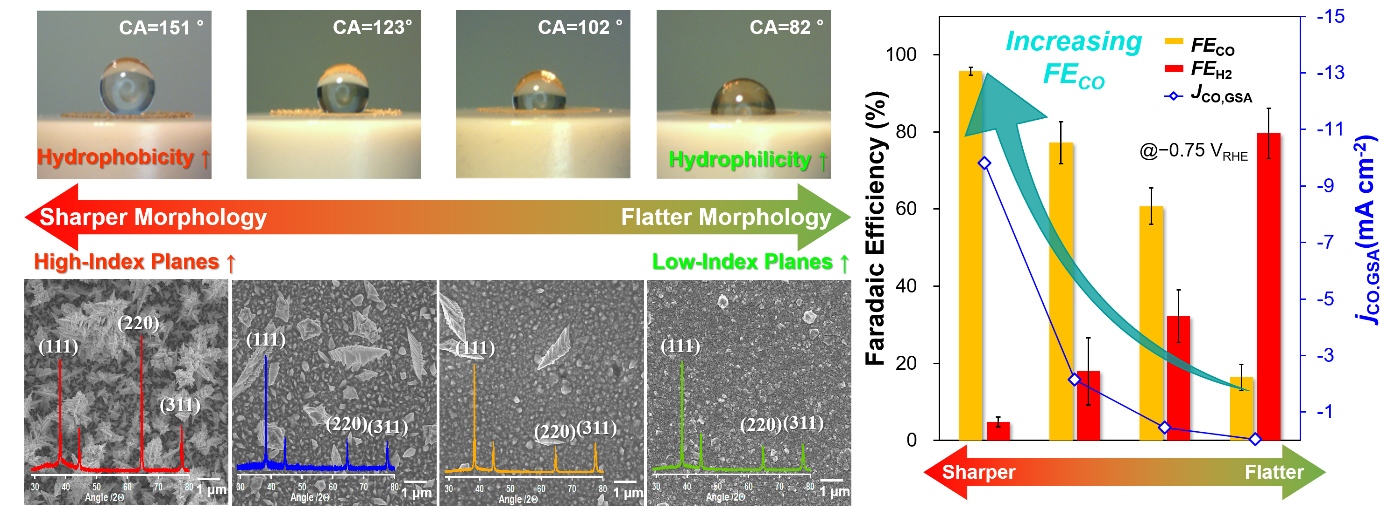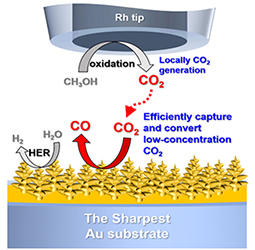본문
Engineering Hydrophobicity and High-Index Planes of Gold Nanostructures for Highly Selective Electrochemical CO2 Reduction to CO and Efficient CO2 Capture

by Prof. Myung Hwa Kim & Prof. Youngmi Lee
Department of Chemistry & Nanoscience
PURE Research Profile – Prof. Myung Hwa Kim & Prof. Youngmi Lee
& Prof. Youngmi Lee
myungkim@ewha.ac.kr & youngmilee@ewha.ac.kr
With increasing emissions of CO2 gas causing environmental threats, the development of CO2 capture and conversion technologies has been of a tremendous interest in current years. Among the various technologies, electrochemical CO2 reduction reaction (CO2RR) has been studied extensively but the poor solubility of CO2 molecule in aqueous solution and competitively occurring hydrogen evolution reaction (HER) are still the problems need to be solved for efficient and selective CO2RR. To solve these problems, we introduced, for the first time, a combination of two types of gold electroatalyst surface engineering: hydrophobicity and high-index planes.
This involved controlling the nanostructures of gold without any further modification. Gold nanostructures having four different morphologies (i.e., degree of roughness) were fabricated via electrodeposition at varied deposition potential, resulting in different intrinsic surface hydrophobicity and exposure of high-index planes depending on the actual morphology. The roughest gold, with its combination of the most hydrophobic feature and abundant high-index planes, generated greater current density (jCO) and faradaic efficiency for CO generation (FECO) than the other gold deposits within a tested potential region as shown in Figure 1.
Moreover, the roughest gold exhibited excellent CO2 capture ability even at low CO2 concentration, confirmed with scanning electrochemical microscopy (SECM) as shown in Figure 2. These improvement at hierarchical gold for CO2RR could be ascribed to two factors. Firstly, the morphology-driven hydrophobicity provides an optimal gas-liquid-solid triple-phase interfaces, increasing the local CO2 concentration near the gold catalyst surface due to its superb CO2 capture ability. Secondly, the abundant high index plane serves as stable active sites for CO2RR, expediting the reaction rates. Remarkably, gold with the highest hydrophobicity and enriched high-index planes, even without any chemical modification, showed excellent CO2RR catalytic performance comparable to or even better than the other previously reported gold-based catalysts.

Figure 1. An illustration showing the hydrophobicity/index planes and faradaic efficiency of CO2RR for CO generation (FECO) depending on the nanostructures of gold.

Figure 2. CO2 capture efficiency monitoring in a close proximity to nanostructured gold surface using SECM.
* Related Article
Taehui Kwon, Sampath Prabhakaran, Do Hwan Kim, Myung Hwa Kim, Youngmi Lee, Engineering Hydrophobicity and High-Index Planes of Gold Nanostructures for Highly Selective Electrochemical CO2 Reduction to CO and Efficient CO2 Capture, Chemical Engineering Journal, Vol. 485, 150045, April 2024.